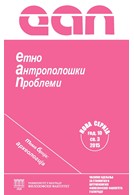Skeuomorphism, Boundary Objects and Socialization of the Chalcolithic Metallurgy in the Southern Levant
Skeuomorphism, Boundary Objects and Socialization of the Chalcolithic Metallurgy in the Southern Levant
Author(s): Milena Gošić AramaSubject(s): Archaeology, Ancient World
Published by: Филозофски факултет, Универзитет у Београду
Keywords: Ghassulian culture; Levant; Chalcolithic metallurgy; ritual; skeuomorphism; boundary objects; socialization
Summary/Abstract: Metalworking emerged in the southern Levant as a new ritual practice during the late phase of the Ghassulian culture, ca. 4300–3900 BC. Ghassulian metalworkers cast objects in both pure and alloyed copper. All the artifacts produced during this time span were ritual. The aim of the present paper is to discuss the socialization process of the Ghassulian metallurgy and its copper objects, by using the concepts of skeuomorphism and boundary objects. Ghassulian copper artifacts can be divided into two groups. The first group consists of artifacts, such as maceheads, chisels and axes, which were produced in stone before the Ghassulian metallurgy appeared. The second group consists of artifacts produced only in metal, including scepters, standards, “crowns” and horns, which were decorated by motifs found on various other early and late Ghassulian ritual artifacts. The artifacts of the first group are skeuomorphic objects, the morphology of which was widely recognized in early and late Ghassulian contexts. These were boundary objects, belonging both to the realm of the new social world of metallurgy and the preexisting world of Ghassulian ritual behavior. Their purpose was to introduce metallurgy to people, both in the Beer Sheva settlements and in other parts of the southern Levant, who did not practice it, as a technology firmly rooted in the Ghassulian tradition. The second group consists of more innovative objects that demonstrated the transformational potential of metallurgy and the superior control metalworkers had over the material world
Journal: Етноантрополошки проблеми
- Issue Year: 10/2015
- Issue No: 3
- Page Range: 717-740
- Page Count: 24
- Language: English

